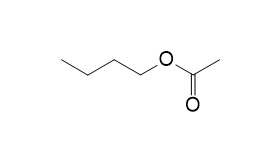Butyl acetate
Butyl acetate is a volatile aroma and flavor compound in apple. Butyl acetate increased conidial adhesion, stimulating conidial germination, and some yeasts can reduce this effect.
Inquire / Order:
manager@chemfaces.com
Technical Inquiries:
service@chemfaces.com
Tel:
+86-27-84237783
Fax:
+86-27-84254680
Address:
1 Building, No. 83, CheCheng Rd., Wuhan Economic and Technological Development Zone, Wuhan, Hubei 430056, PRC
Providing storage is as stated on the product vial and the vial is kept tightly sealed, the product can be stored for up to
24 months(2-8C).
Wherever possible, you should prepare and use solutions on the same day. However, if you need to make up stock solutions in advance, we recommend that you store the solution as aliquots in tightly sealed vials at -20C. Generally, these will be useable for up to two weeks. Before use, and prior to opening the vial we recommend that you allow your product to equilibrate to room temperature for at least 1 hour.
Need more advice on solubility, usage and handling? Please email to: service@chemfaces.com
The packaging of the product may have turned upside down during transportation, resulting in the natural compounds adhering to the neck or cap of the vial. take the vial out of its packaging and gently shake to let the compounds fall to the bottom of the vial. for liquid products, centrifuge at 200-500 RPM to gather the liquid at the bottom of the vial. try to avoid loss or contamination during handling.
BMC Plant Biol.2020, 20(1):214.
Thorac Cancer.2023, 14(21):2007-2017.
Anticancer Res.2022, 42(9):4403-4410.
Molecules.2022, 27(21):7643.
Toxins (Basel).2019, 11(10):E575
Food Bioscience2022, 50:102187.
Chem Biodivers.2023, 20(10):e202300741.
Data Science for Genomics2023, 107-128.
International Food Research Journal2018, 25(6):2560-2571
Mol Med Rep.2014, 9(5):1653-9
Related and Featured Products
Journal of Chemical Ecology, 2001, 27(4):831-844.
Butyl acetate and yeasts interact in adhesion and germination of Botrytis cinerea conidia in vitro and in fungal decay of golden delicious apple.[Reference:
WebLink]
Butyl acetate is a volatile aroma and flavor compound in apple.
METHODS AND RESULTS:
Conidia of three strains of Botrytis cinerea, a fungus that causes decay of apple fruit in postharvest storage, had greater adhesion to and greater germination on polycarbonate membrane filters on water inside sealed 500 cc glass jars that were injected with 4 μl Butyl acetate than conidia not so exposed. Conidial germination was highly correlated with conidial adhesion. The yeasts Sporobolomyces roseus and Cryptococcus laurentii, but not Saccharomyces cerevisiae, reduced the adhesion and germination promoting effect of Butyl acetate. Conidia did not readily utilize Butyl acetate as a food source, as shown by lack of tetrazolium violet reduction, whereas S. roseus and C. laurentii, but not S. cerevisiae did. Butyl acetate added to suspensions of conidia increased the electrical conductivity of the suspensions and increased the loss of 14C from 14C-labeled conidia compared to conidia unexposed to Butyl acetate. Uptake of [14C]glucose by conidia was not increased by Butyl acetate. Wounds of Golden Delicious apples inoculated with conidia (strain F-J-4) in a dilute solution of Butyl acetate had greater decay than unexposed wounds. S. roseus and C. laurentii, but not S. cerevisiae, added with the conidia decreased the incidence or size of decay.
CONCLUSIONS:
Results indicated that Butyl acetate increased conidial adhesion, stimulating conidial germination, and some yeasts can reduce this effect.



